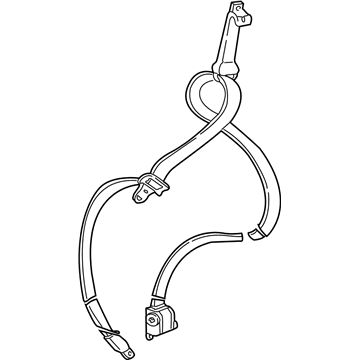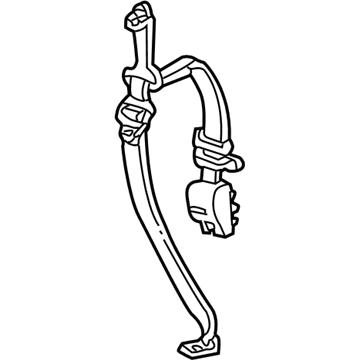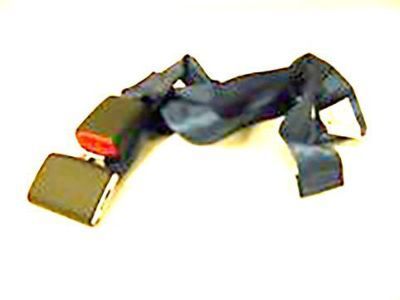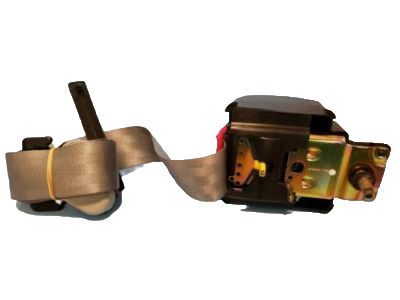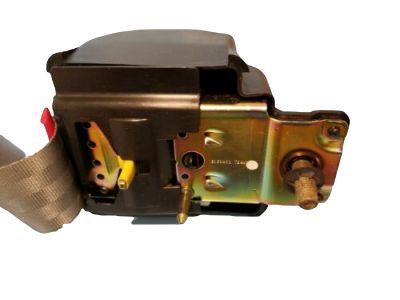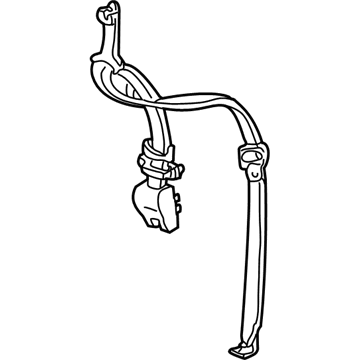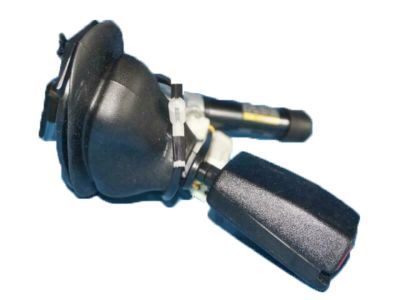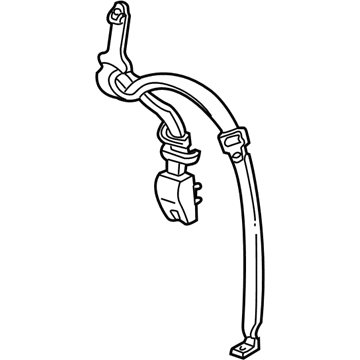FordParts
My Garage
My Account
Cart
OEM 2003 Ford E-150 Seat Belt
Seat Safety Belt- Select Vehicle by Model
- Select Vehicle by VIN
Select Vehicle by Model
orMake
Model
Year
Select Vehicle by VIN
For the most accurate results, select vehicle by your VIN (Vehicle Identification Number).
13 Seat Belts found

2003 Ford E-150 Lap & Shoulder Belt, Front Driver Side Part Number: 6C2Z-15611B09-BA
$227.62 MSRP: $281.53You Save: $53.91 (20%)Product Specifications- Other Name: Seat Belt Assembly; Seat Belt Lap and Shoulder Belt, Front Left
- Manufacturer Note: (-E*)
- Position: Front Driver Side
- Replaces: 2C2Z-15611B09-AAD, 2C2Z-15611B09-AAC, 6C2Z-15611B09-AAA, XC2Z-15611B09-AAC, XC2Z-15611B09-AAA
- Base No.: 611B09
- Item Weight: 3.60 Pounds
- Item Dimensions: 8.1 x 6.0 x 16.8 inches
- Condition: New
- Fitment Type: Direct Replacement
- SKU: 6C2Z-15611B09-BA
- Warranty: This genuine part is guaranteed by Ford's factory warranty.

2003 Ford E-150 Lap & Shoulder Belt, Front Passenger Side Part Number: 6C2Z-15611B08-BA
$186.68 MSRP: $271.73You Save: $85.05 (32%)Ships in 1-3 Business DaysProduct Specifications- Other Name: Seat Belt Assembly; Seat Belt Lap and Shoulder Belt, Front Right
- Manufacturer Note: (-E*)
- Position: Front Passenger Side
- Replaces: 4C2Z-15611B08-AAC, 4C2Z-15611B08-AAD, 2C2Z-15611B08-AAC, 2C2Z-15611B08-AAD, 6C2Z-15611B08-AAA
- Base No.: 611B08
- Item Weight: 3.20 Pounds
- Item Dimensions: 10.5 x 6.3 x 4.1 inches
- Condition: New
- Fitment Type: Direct Replacement
- SKU: 6C2Z-15611B08-BA
- Warranty: This genuine part is guaranteed by Ford's factory warranty.
2003 Ford E-150 Rear Seat, Outer Passenger Side Part Number: 3C2Z-16611B68-BAA
$141.97 MSRP: $196.41You Save: $54.44 (28%)Ships in 1-2 Business DaysProduct Specifications- Other Name: Seat Belt Assembly; Seat Belt Lap and Shoulder Belt, Rear Right Outer; Lap & Shoulder Belt
- Position: Rear Outer Passenger Side
- Replaces: 3C2Z-16611B68-BAB
- Base No.: 611B68
- Item Weight: 3.70 Pounds
- Condition: New
- Fitment Type: Direct Replacement
- SKU: 3C2Z-16611B68-BAA
- Warranty: This genuine part is guaranteed by Ford's factory warranty.
 Product Specifications
Product Specifications- Other Name: Seat Belt Assembly; Seat Belt Lap and Shoulder Belt, Rear Left Outer
- Manufacturer Note: (-W*)
- Position: Rear Outer Driver Side
- Replaces: 6C2Z-16611B69-CAB, 3C2Z-16611B69-CAB
- Base No.: 611B69
- Item Weight: 3.80 Pounds
- Condition: New
- Fitment Type: Direct Replacement
- SKU: 6C2Z-16611B69-FB
- Warranty: This genuine part is guaranteed by Ford's factory warranty.
 Product Specifications
Product Specifications- Other Name: Seat Belt Assembly; Seat Belt Lap and Shoulder Belt, Rear Right Outer; Lap & Shoulder Belt
- Position: Rear Outer Passenger Side
- Replaces: 3C2Z-16611B68-AAB
- Base No.: 611B68
- Item Weight: 3.50 Pounds
- Item Dimensions: 6.0 x 4.7 x 11.3 inches
- Condition: New
- Fitment Type: Direct Replacement
- SKU: 3C2Z-16611B68-AAA
- Warranty: This genuine part is guaranteed by Ford's factory warranty.

2003 Ford E-150 Buckle, Front Passenger Side Part Number: F8UZ-1561202-AAA
$162.34 MSRP: $236.30You Save: $73.96 (32%)Product Specifications- Other Name: Pretensioner - Seat Belt Buckle; Seat Belt Receptacle, Front Right; Latch
- Position: Front Passenger Side
- Replaces: F7UZ-1561202-AEJ
- Base No.: 61202
- Item Weight: 4.40 Pounds
- Item Dimensions: 16.5 x 13.3 x 8.1 inches
- Condition: New
- Fitment Type: Direct Replacement
- SKU: F8UZ-1561202-AAA
- Warranty: This genuine part is guaranteed by Ford's factory warranty.
- Product Specifications
- Other Name: Seat Belt Assembly; Seat Belt Lap and Shoulder Belt, Rear Left Outer; Lap & Shoulder Belt
- Manufacturer Note: (-E*)
- Position: Rear Outer Driver Side
- Replaces: 3C2Z-16611B69-BAA, 6C2Z-16611B69-BAA
- Base No.: 611B69
- Item Weight: 0.80 Pounds
- Condition: New
- Fitment Type: Direct Replacement
- SKU: 6C2Z-16611B69-EA
- Warranty: This genuine part is guaranteed by Ford's factory warranty.
- Product Specifications
- Other Name: Seat Belt Assembly; Seat Belt Lap and Shoulder Belt, Rear Left Outer; Lap & Shoulder Belt
- Manufacturer Note: (-E*)
- Position: Rear Outer Driver Side
- Replaces: 3C2Z-16611B69-AAA, 6C2Z-16611B69-AAA
- Base No.: 611B69
- Item Weight: 3.80 Pounds
- Condition: New
- Fitment Type: Direct Replacement
- SKU: 6C2Z-16611B69-DA
- Warranty: This genuine part is guaranteed by Ford's factory warranty.
- Product Specifications
- Other Name: Seat Belt Assembly; Seat Belt Lap and Shoulder Belt, Rear Left Outer; Lap & Shoulder Belt
- Manufacturer Note: (-W*)
- Position: Rear Outer Driver Side
- Replaces: 3C2Z-39611B69-AAB, 6C2Z-39611B69-AAB
- Base No.: 611B69
- Item Weight: 4.10 Pounds
- Condition: New
- Fitment Type: Direct Replacement
- SKU: 6C2Z-39611B69-BB
- Warranty: This genuine part is guaranteed by Ford's factory warranty.
- Product Specifications
- Other Name: Seat Belt Assembly; Seat Belt Lap and Shoulder Belt, Rear Right Outer; Lap & Shoulder Belt
- Manufacturer Note: (-E*)
- Position: Rear Outer Passenger Side
- Replaces: 3C2Z-39611B68-AAA, 6C2Z-39611B68-AAA
- Base No.: 611B68
- Item Weight: 4.00 Pounds
- Item Dimensions: 6.0 x 4.6 x 11.2 inches
- Condition: New
- Fitment Type: Direct Replacement
- SKU: 6C2Z-39611B68-BA
- Warranty: This genuine part is guaranteed by Ford's factory warranty.
- Product Specifications
- Other Name: Seat Belt Assembly; Seat Belt Lap and Shoulder Belt, Rear Right Outer; Lap & Shoulder Belt
- Position: Rear Outer Passenger Side
- Replaces: 3C2Z-16611B68-DAB
- Base No.: 611B68
- Item Weight: 4.20 Pounds
- Condition: New
- Fitment Type: Direct Replacement
- SKU: 3C2Z-16611B68-DAA
- Warranty: This genuine part is guaranteed by Ford's factory warranty.
- Product Specifications
- Other Name: Seat Belt Assembly; Seat Belt Lap and Shoulder Belt, Rear Left Outer; Lap & Shoulder Belt
- Position: Rear Outer Driver Side
- Base No.: 611B69
- Item Weight: 3.70 Pounds
- Condition: New
- Fitment Type: Direct Replacement
- SKU: 3C2Z-16611B69-BAB
- Warranty: This genuine part is guaranteed by Ford's factory warranty.
- Product Specifications
- Other Name: Seat Belt Assembly; Seat Belt Lap and Shoulder Belt, Rear Right Outer
- Position: Rear Outer Passenger Side
- Replaces: 3C2Z-16611B68-EAB
- Base No.: 611B68
- Item Weight: 3.50 Pounds
- Item Dimensions: 6.1 x 4.6 x 11.2 inches
- Condition: New
- Fitment Type: Direct Replacement
- SKU: 3C2Z-16611B68-EAA
- Warranty: This genuine part is guaranteed by Ford's factory warranty.
2003 Ford E-150 Seat Belt
If you're seeking quality and affordability, look no further than our extensive inventory of genuine 2003 Ford E-150 Seat Belt available at FordPartsDeal.com. You can confidently purchase our OEM 2003 Ford E-150 Seat Belt as they are supported by the manufacturer's warranty and our hassle-free return policy, alongside the benefit of our fast delivery service.
2003 Ford E-150 Seat Belt Parts Q&A
- Q: What Precautions Should Be Taken When Servicing a Deployed Seat Belt Pretensioner on 2003 Ford E-150?A: A deployed safety belt pretensioner requires disposal methods identical to other scrap parts. Personal safety requires the usage of safety glasses to perform repairs on vehicles with air bags and when interacting with safety belt buckle pretensioners since they operate as a pyrotechnic device. Military personnel should never push or probe the electrical connector of the pretensioner since this contact could unknowingly release the pretensioner or air bag which represents a danger of bodily injury.

